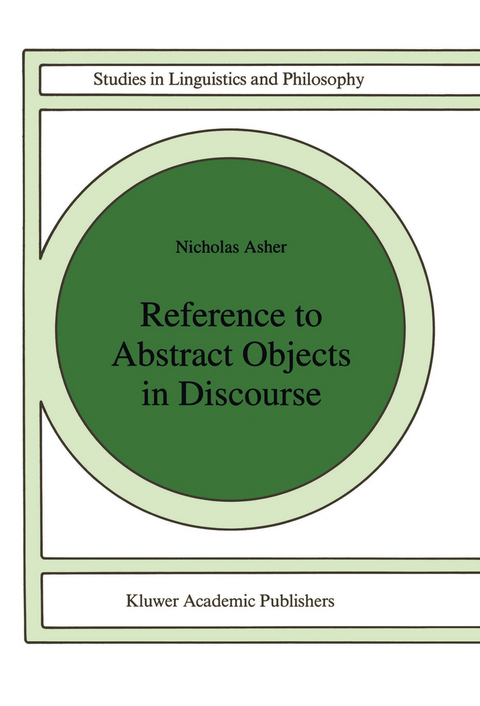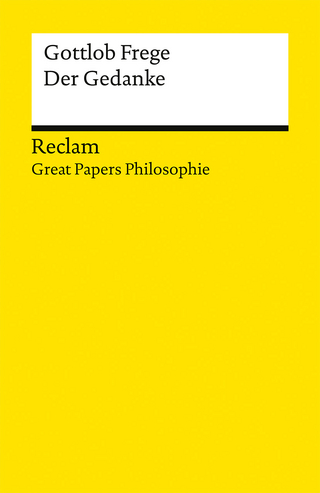
Reference to Abstract Objects in Discourse
Springer (Verlag)
978-0-7923-2242-9 (ISBN)
For semanticists, philosophers of language, computer scientists interested in natural language applications and discourse, philosophical logicians, graduate students in linguistics, philosophy, cognitive science and artificial intelligence.
1 — From Events to Propositions: A Tour of Abstract Entities, Eventualities and the Nominals That Denote Them.- 1. Distributional Data and the Typology of Abstract Entities.- 2. Quantification, Abstract Object Anaphora and the Typology of Abstract Objects.- 3. Principles of Summation and Structured Domains for Abstract Entities.- 4. Provisional Conclusions.- 2 - A Crash Course in Drt.- 1. A Philosophical Overview of the Aims of Discourse Representation Theory.- 2. The Basic Fragment.- 3. Expanding the Fragment: Events in DRT.- 4. Plurals in DRT.- 5. Appendix: Formalization of DRS Construction and DRS Interpretation.- 3 — Attitudes and Attitude Descriptions.- 1. Attitudes and Attitude Formation.- 2. Attitudes, Operators, and Predicates.- 3. Interpreting Attitude Ascriptions.- 4. Concepts and Attitudes.- 5. Attitudes, Propositions, and Representations.- 6. Conclusions.- 4 — The Semantic Representation for Sentential Nominals.- 1. Syntactic and Semantic Assumptions and Basic Principles.- 2. Derived Nominals.- 3. Of-ing Gerund Phrases and Bare Nominals.- 4. That Clauses.- 5. More Abstract Nominals: Infinitivais and Projective Propositions.- 5 — Problems For The Semantics Of Nominals.- 1. IP Gerunds and Some Data About Them.- 2. The Syntactic and Semantic Analysis of IP Gerunds.- 3. Naked Infinitives 204.- 4. Correspondences and Connections Between Abstract Objects.- 5. The Problem of Event Negation Solved.- 6. Conclusions Concerning DRS Construction for Nominals: Lessons for Natural Language Metaphysics.- 6 — Anaphora and Abstract Entities.- 1. Toward a Unified Analysis of Abstract Entity Anaphora.- 2. Event Anaphora.- 3. Event-Type Anaphora and Using Event-Types to Construct Event Sums.- 4. Proposition Anaphora.- 5. Fact Anaphora.- 6. Concept Anaphora in DRT.- 7— A Theory Of Discourse Structure for an Analysis of Abstract Entity Anaphora.- 1. The Problem of Discourse Structure and Anaphora.- 2. Discourse Structure and Discourse Representation Theory.- 3. Discourse Relations and Their Semantics.- 4. Principles of Discourse Segmentation and SDRS Constituent Construction.- 5. Revision of Constituents after Updating.- 6. Taking Stock.- 7. Appendix of Definitions and Constraints in Chapter 7.- 8 - Applying the Theory of Discourse Structure to the Anaphoric Phenomena.- 1. Constraints on Abstract Object Anaphora Derived from an SDRS: Availability and Well-Foundedness.- 2. Some Examples of Proposition Anaphora.- 3. Availability, Anaphora and Constituent Revision.- 4. Discourse Subordination.- 5. Event and Plural Anaphora Revisited.- 6. Anaphoric Connections Across Different Abstract Types.- 7. Conclusions About Abstract Anaphora.- 9 — Applications of The Theory of Discourse Structure to Concept Anaphora and Vp Ellipsis.- 1. Extending SDRS Theory.- 2. Examples of Overt Concept Anaphora.- 3. VP Ellipsis.- 4. Sloppy Identity.- 5. Concluding Thoughts on Abstract Entity Anaphora.- 6. Appendix of Definitions and Constraints for Concept Anaphora.- 10 — Model Theory for Abstract Entities and its Philosophical Implications.- 1. First Order or Higher Order DRT?.- 2. Intentional Frames and Intensional Contents.- 3. Problems of Self-Reference.- 4. Two Arguments for a Representational Theory of Abstract Entities.- 5. Metaphysical Representationalism and Metaphysical Reduction.- 6. Technical Appendix.- Conclusion.
| Reihe/Serie | Studies in Linguistics and Philosophy ; 50 |
|---|---|
| Zusatzinfo | IX, 455 p. |
| Verlagsort | Dordrecht |
| Sprache | englisch |
| Maße | 152 x 229 mm |
| Themenwelt | Geisteswissenschaften ► Philosophie ► Logik |
| Geisteswissenschaften ► Philosophie ► Sprachphilosophie | |
| Geisteswissenschaften ► Sprach- / Literaturwissenschaft ► Sprachwissenschaft | |
| Sozialwissenschaften | |
| ISBN-10 | 0-7923-2242-8 / 0792322428 |
| ISBN-13 | 978-0-7923-2242-9 / 9780792322429 |
| Zustand | Neuware |
| Haben Sie eine Frage zum Produkt? |
aus dem Bereich


